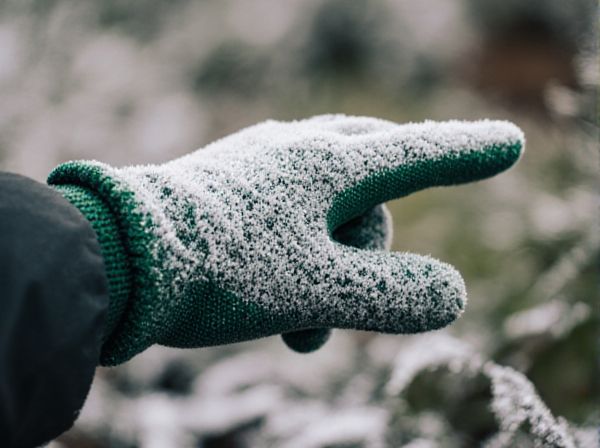
Frost Hardy vs Frost Tender Illustration
Frost hardy plants withstand freezing temperatures and survive winter conditions without damage, making them ideal for colder climates. In contrast, frost tender plants are vulnerable to frost and require protection or relocation during cold weather to prevent injury. Understanding the frost hardiness of plants is crucial for effective gardening and agriculture in regions prone to frost.
Table of Comparison
| Aspect | Frost Hardy | Frost Tender |
|---|---|---|
| Temperature Tolerance | Survives below 0degC (32degF) | Damaged above 0degC (32degF) |
| Climate Suitability | Cold, temperate climates | Warm, tropical, subtropical climates |
| Plant Examples | Carrots, kale, broccoli | Tomatoes, peppers, basil |
| Growing Season | Extended cold seasons | Short warm seasons |
| Soil Requirements | Well-drained, frost-resistant soils | Moist, frost-free soils |
Understanding Frost Hardy and Frost Tender Plants
Frost hardy plants possess the ability to survive and thrive in freezing temperatures by developing protective mechanisms such as antifreeze proteins and thicker cell walls, making them suitable for cold climates. Frost tender plants lack these adaptations, causing their cells to rupture when exposed to frost, which results in damage or death, so they require warmer growing conditions or protective measures. Understanding these differences is crucial for selecting appropriate species for landscaping and agriculture in regions prone to frost events.
Key Characteristics of Frost Hardy Species
Frost hardy species possess cellular mechanisms such as antifreeze protein production and membrane stabilization that enable survival at subzero temperatures, ensuring sustained metabolic activity during cold spells. These plants often exhibit morphological adaptations like thicker cuticles and reduced leaf surface area to minimize frost damage and water loss. Their resilience makes them suitable for cultivation in temperate and alpine climates where frost occurrence is frequent and severe.
Traits Defining Frost Tender Plants
Frost tender plants exhibit traits such as thin, delicate foliage and higher water content in tissues, making them susceptible to cellular damage when exposed to freezing temperatures. These plants lack protective mechanisms like antifreeze proteins or robust cell walls that frost hardy species possess. The inability to withstand ice crystal formation in their cells results in browning, wilting, and often plant death after frost events.
Climate Zones and Frost Risk Explained
Frost hardy plants thrive in USDA Climate Zones 3 to 7 where temperatures can drop below 20degF, maintaining growth despite frost exposure. Frost tender plants require warmer zones like 8 to 11, as they are vulnerable to frost damage and need protection in climates with occasional freezes. Understanding frost risk involves analyzing local minimum temperatures and frost dates to select appropriate species for sustainable landscaping and agriculture.
Selecting the Right Plants for Your Garden Climate
Selecting frost hardy plants ensures your garden thrives in colder climates by withstanding temperatures below freezing, reducing winter damage and promoting year-round growth. Frost tender plants require warmer conditions, as exposure to frost can cause significant injury or death, making them ideal for regions with mild winters or for seasonal planting. Understanding local frost dates and temperature ranges guides gardeners in choosing species suited to their climate, optimizing plant survival and garden productivity.
Tips for Protecting Frost Tender Plants
Frost tender plants require careful protection during cold weather to prevent damage from frost. Use methods such as covering plants with frost cloths or blankets, mulching the soil to retain warmth, and placing containers indoors or in sheltered locations overnight. Avoid watering plants late in the day, as wet foliage can increase frost damage risks.
Advantages of Growing Frost Hardy Plants
Frost hardy plants withstand subfreezing temperatures without significant damage, ensuring year-round growth and reducing seasonal crop loss. These plants require less protective measures, lowering maintenance costs and labor for gardeners and farmers. Their resilience supports sustainable agriculture by enhancing food security in colder climates.
Common Examples of Frost Hardy and Frost Tender Varieties
Frost hardy plants, such as kale, Brussels sprouts, and pansies, can withstand freezing temperatures and continue thriving through cold weather. Frost tender varieties like tomatoes, basil, and impatiens are vulnerable to frost damage and typically require protection until warmer temperatures return. Choosing the right frost hardy or tender plants is essential for successful gardening in regions with varying winter conditions.
Seasonal Planting Strategies for Frost-Prone Regions
Frost hardy plants, capable of withstanding temperatures below freezing, are ideal for early spring and late fall planting in frost-prone regions, ensuring survival and growth despite cold snaps. Frost tender species require protection or planting after the last expected frost date, benefiting from season extension techniques like row covers or greenhouses to avoid frost damage. Seasonal planting strategies must align with local frost calendars and microclimate conditions to optimize crop success and minimize frost-related losses.
Adapting Your Garden to Changing Frost Patterns
Frost hardy plants withstand freezing temperatures and are crucial for gardens experiencing unpredictable frost dates due to climate change. Selecting frost hardy species ensures resilience against late spring frosts or early autumn frosts, minimizing crop damage and loss. Incorporating frost tender plants near sheltered areas or using protective covers can also help manage frost risk in evolving garden conditions.
Frost Hardy vs Frost Tender Infographic

 gardendif.com
gardendif.com